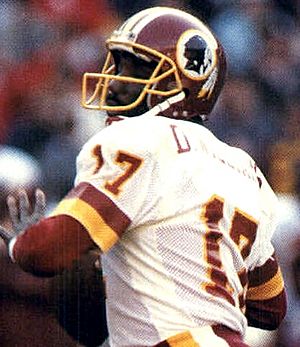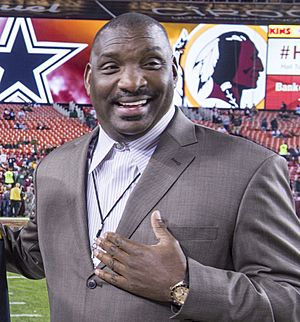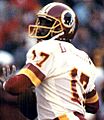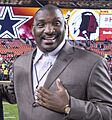Doug Williams (quarterback) facts for kids
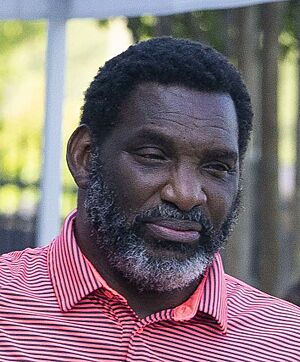
Williams in 2021
|
|||||||||||||
| Washington Commanders | |||||||||||||
|---|---|---|---|---|---|---|---|---|---|---|---|---|---|
| Position: | Senior advisor | ||||||||||||
| Personal information | |||||||||||||
| Born: | August 9, 1955 Zachary, Louisiana, U.S. |
||||||||||||
| Height: | 6 ft 4 in (1.93 m) | ||||||||||||
| Weight: | 220 lb (100 kg) | ||||||||||||
| Career information | |||||||||||||
| High school: | Chaneyville (Zachary) | ||||||||||||
| College: | Grambling State (1974–1977) | ||||||||||||
| NFL Draft: | 1978 / Round: 1 / Pick: 17 | ||||||||||||
| Career history | |||||||||||||
| As player: | |||||||||||||
|
|||||||||||||
| As coach: | |||||||||||||
|
|||||||||||||
| As executive: | |||||||||||||
|
|||||||||||||
| Career highlights and awards | |||||||||||||
|
|||||||||||||
| Career NFL statistics | |||||||||||||
|
|||||||||||||
| Head coaching record | |||||||||||||
| Career: | 64–42 (.604) | ||||||||||||
| Player stats at PFR | |||||||||||||
|
College Football Hall of Fame
|
|||||||||||||
Doug Williams, born on August 9, 1955, is a famous American football player, coach, and executive. He is currently a senior advisor for the Washington Commanders in the National Football League (NFL). Doug Williams made history as the first Black quarterback to start and win a Super Bowl. He achieved this with the Washington Redskins (now Commanders) in Super Bowl XXII. He was even named the Super Bowl MVP after throwing four touchdowns in just one quarter!
After his playing days, Williams became a coach. He was the head coach for the Grambling State Tigers. Later, he worked as a team executive for the Tampa Bay Buccaneers, Virginia Destroyers, and the Commanders.
Contents
College Football Career
Doug Williams played quarterback for the Grambling State Tigers from 1974 to 1977. During his first two seasons, he played alongside future NFL receiver Sammy White. Williams led the Tigers to an amazing 36 wins and only 7 losses as a four-year starter. He also helped them win three Southwestern Athletic Conference Championships. Williams was named Black College Player of the Year twice.
In 1977, Williams was a top player in college football. He led the NCAA in total yards (3,249), passing yards (3,286), and touchdown passes (38). He finished fourth in the Heisman Trophy voting, which is a huge honor. Williams earned a bachelor's degree in education from Grambling.
Even with all his success, only one NFL coach, Joe Gibbs from the Tampa Bay Buccaneers, came to scout him. Gibbs spent two days with Williams, reviewing plays and practicing throws. Gibbs was very impressed by Williams' calm attitude and hard work. He believed Williams was the best quarterback in the draft.
Professional Football Journey
Playing for the Tampa Bay Buccaneers
Based on Joe Gibbs' recommendation, Tampa Bay chose Williams in the first round of the 1978 NFL draft. He was the first African-American quarterback ever picked in the first round of an NFL draft. In his first preseason game, his long pass drew a standing ovation from the crowd. He was the first quarterback for the Buccaneers who could throw the ball far down the field.
In 1979, Williams and Chicago Bears quarterback Vince Evans made history. Their game was the first NFL game to have a Black starting quarterback on both teams. The Tampa Bay Buccaneers had only won two games in their first two years. But with Williams as their starter, they made it to the playoffs three times in five seasons. They even played in the 1979 NFC Championship game. Williams improved his passing accuracy every season he played for Tampa Bay.
Williams was the only starting African-American quarterback in the NFL at that time. He faced unfair treatment from some fans and even some coaches. He was paid much less than other starting quarterbacks in the league. After the 1982 season, Williams asked for a higher salary. The team owner, Hugh Culverhouse, refused to pay him what he felt he deserved. Because of this disagreement, Williams decided not to play in the 1983 season. That year, the Buccaneers won only two games. They did not make the playoffs again for 14 years.
Playing in the USFL
After a year away from the NFL, Williams joined the United States Football League (USFL). He signed with the Oklahoma Outlaws. He signed a large contract, making him one of the highest-paid players in football. Williams later said that the Outlaws' owners treated him with respect.
In 1984, Williams led the Oklahoma Outlaws in passing yards. He completed 261 passes for 3,084 yards and 15 touchdowns. In 1985, the team moved to Arizona and became the Arizona Outlaws. Williams improved his play, throwing for 3,673 yards and 21 touchdowns.
Joining the Washington Redskins
When the USFL closed down in 1986, Williams returned to the NFL. He joined the Washington Redskins, where he was reunited with his former coach, Joe Gibbs. Williams started as a backup quarterback. However, when the starting quarterback, Jay Schroeder, got injured, Williams stepped in. He led the Redskins to a victory in their first game of the 1987 season. Williams helped the team win three games in 1987 when he filled in for Schroeder.
At the end of the 1987 season, the Redskins made it to the playoffs. Williams was chosen as the starting quarterback. He led the team to Super Bowl XXII, where they defeated the Denver Broncos. This made him the first Black quarterback to both play in and win a Super Bowl.
The day before Super Bowl XXII, Williams had a long dental surgery. But on January 31, 1988, he led his team to a huge 42–10 victory over the Broncos. Williams completed 18 passes for 340 yards and threw four touchdown passes. All four touchdowns were thrown in the second quarter, which set a Super Bowl record! This amazing performance helped the Redskins score 35 points in that quarter, putting the game out of reach. He was named the Super Bowl MVP for his incredible efforts. This made him the first African-American quarterback to win a Super Bowl and be named its MVP.
Williams faced injuries the next season. Mark Rypien eventually took over as the starting quarterback. Even though they were competing for the same job, Williams and Rypien supported each other. They were so supportive that T-shirts were sold that said "United We Stand," showing them as cartoon characters. Williams played one more season in 1989 as Rypien's backup.
Williams left the Redskins because of money. The team decided to sign a cheaper backup quarterback. Williams felt that other teams did not show much interest in him, which he believed was due to unfair treatment. He retired from playing with a record of 38 wins, 42 losses, and 1 tie as a regular season starter. He threw 100 touchdown passes and scored 15 rushing touchdowns in 88 NFL games.
Coaching and Executive Roles
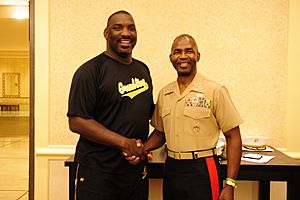
After his NFL playing career, Williams worked as a college football analyst on television in 1990. However, he missed being involved in football. In 1991, he became a high school head coach in Louisiana. He led his team to a 5–5 record, including a big upset win.
In 1992, Williams coached at his old high school, now called Northeast High. The team played on a field named after him. He led them to an undefeated regular season. In 1993, his team even beat a team led by future NFL star Peyton Manning in the playoffs.
Williams then moved to college coaching in 1994. He was hired as the running backs coach for the United States Naval Academy. He also worked as an offensive coordinator for a team in Europe and as a scout for the Jacksonville Jaguars.
Williams became a college head coach at Morehouse College in 1997. In 1998, he became the head football coach at Grambling State University, taking over from the famous coach Eddie Robinson. He led the Tigers to three straight Southwestern Athletic Conference titles from 2000 to 2002. After this success, he returned to the Tampa Bay Buccaneers as a personnel executive.
In 2008, on the 20th anniversary of his Super Bowl XXII MVP award, Williams carried the Vince Lombardi Trophy onto the field for the Super Bowl XLII presentation. In 2009, he was named the director of professional scouting for the Tampa Bay Buccaneers. He left this position in 2010.
Williams then became the general manager for the Virginia Destroyers in the United Football League. In 2011, he resigned from the Destroyers to become the head football coach at Grambling State University for a second time. He was fired from this coaching position in 2013.
In February 2014, Williams rejoined the Redskins as a personnel executive. He was promoted to Senior Vice President of Player Personnel in 2017. In 2020, he became the team's senior vice president of player development. Since 2021, he has been a senior advisor to the team president of the Washington Commanders.
Personal Life
Doug Williams was born in Zachary, Louisiana. He has been married three times and has several children. His sons, Adrian and D.J., are also talented college athletes. Adrian played basketball for Brown University, and D.J. played football for his father at Grambling State University. His daughter Laura plans to play basketball at the University of Southern California in 2024. Doug's nephew, Johnny Huggins, also played in the NFL.
In 2009, Williams and another Grambling State alumnus, James "Shack" Harris, started the Black College Football Hall of Fame. Each year, they honor great football players from historically Black colleges and universities. In July 2019, Grambling State honored Williams by naming a street on their campus after him.
Images for kids
-
Williams (left) as head coach of Grambling State posing with Marine general Ronald L. Bailey (right) in 2011
See also
 In Spanish: Doug Williams para niños
In Spanish: Doug Williams para niños


